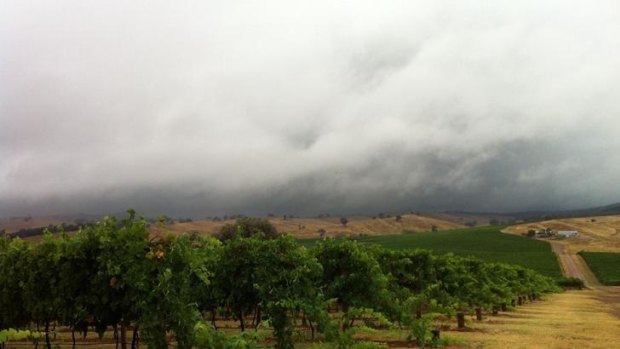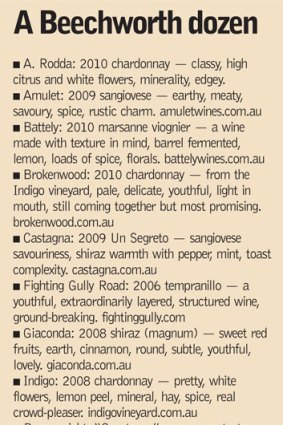''BEECHWORTH terroir'' was the subject of a recent look-see into the small wine region that sits right in the middle of north-east Victoria.
The star of the show, terroir - the special relationship between climate and soil that can make wine so interesting - made itself known when the thermometer hit 35-plus degrees on day one.

Beechworth's vineyards benefit from higher rainfall, cooler temperatures and unusual soil composition.
Refuge was found in the 15-degree cool of Rick Kinzbrunner's Giaconda wine cave, detonated out of diamond-hard granite rock, outside town. Beechworth, it was noted, experiences a high degree of continentality. ''Summers are hot and dry,'' the vignerons' seminar brief explained, and ''only deep-rooted plants keep green during the warmest months''. Here was said heat in spades and, yes, plenty of green vines, too.
The next day, more than 25 millimetres of rain fell. The town's gutters overflowed. Flash flooding occurred. Temperatures dropped.

Beechworth's vineyards lie in the Great Dividing Range's western foothills, which receive more rain than neighbouring areas. The hills are between 300 metres and 800 metres high, which leads to cooler temperatures. The south-facing slopes (cool) are where chardonnay and increasingly, nebbiolo, are grown, while the warmer north-facing slopes are suitable for shiraz and sangiovese.
But what separates Beechworth from so many other regions, and the thing that really gets wine geeks going, is minerality. It's there, you can see it, with minerals glistening in the sun - slate and shale and great boulders of granite. There are parts that cannot be planted to vines because boulders are in the way.
While some disagree, you can taste minerality and it's there in the wines. Winemakers argue it brings not only structure but also longevity to wines. Minerality is one of the many things I enjoy about Beechworth as a wine region. That, and chardonnay and shiraz.
This is not a place for sparklings but is most definitely the spot for structured chardonnay and, increasingly, shiraz. Julian Castagna at Castagna believes sangiovese has a big future, too, while Barry Morey at Sorrenberg would probably suggest gamay. Savaterre's Keppell Smith might say pinot noir, while Stephen Morris at Pennyweight - the only producer pursuing fortifieds - would champion his palomino-based apera.
Yes, there is a lot happening down among the terroir of Beechworth but let's not forget the work performed in the winery.
''I'm not exactly non-interventionist,'' Rick Kinzbrunner says of his philosophy. ''I do a lot of things in the winemaking. I don't leave the vineyard to do it.''
Beechworth winemakers tend to have come from somewhere else and to have had other jobs before finding their new home. A fair few were once employed at that fertile breeding ground just down the road at Milawa, Brown Brothers. Their styles are their own. Some, such as Marc Scalzo at Piano Piano (a charming Italian name that means ''slowly slowly''), just want to explore what Beechworth fruit can do. ''I want to see the site in the wine,'' he says.
Kinzbrunner, Castagna and Smith are confident about what the fruit can do. They take risks and are happy to explore everything that might provide their wines with complexity and depth: natural yeasts, wild ferments, a second malolactic fermentation (to soften acidity), no fining, little filtration. Basket presses get a big look-in up this way. Some winemaking styles are deliberately ''dirty'' or ''funky''. There is a sense of adventure. Everything seems possible and it is - sometimes we forget this is a young winemaking region.
In a year such as 2010, after a run of drought and fires, winemakers encountered an excellent vintage, one worth celebrating with some of that edgy winemaking. There are few Beechworth wines vintaged 2010 that don't sing with strong fruit, moderate alcohols and good natural acidity and structure.
As for the ageing potential of Beechworth and that small, albeit controversial, question of minerality?
Let's just say the questions were answered most convincingly by two wines: Giaconda 1993 chardonnay (in magnum) and Sorrenberg 1996 sauvignon blanc-semillon.
And, yes, you read that last wine correctly.